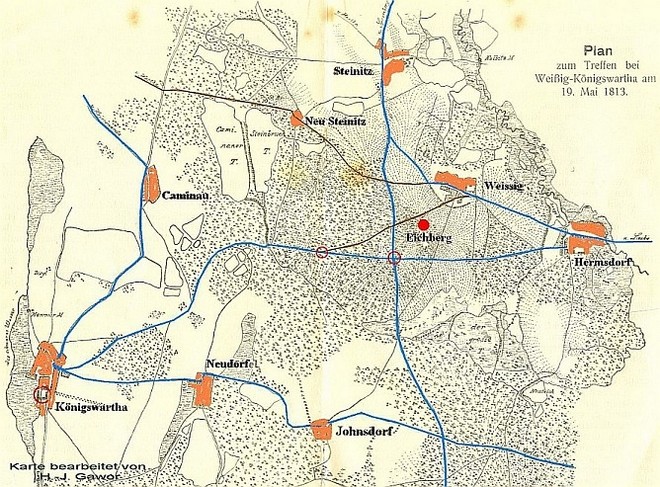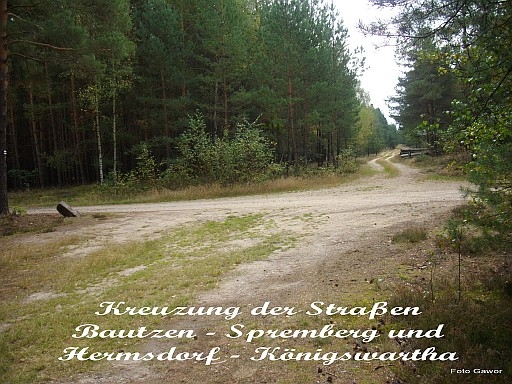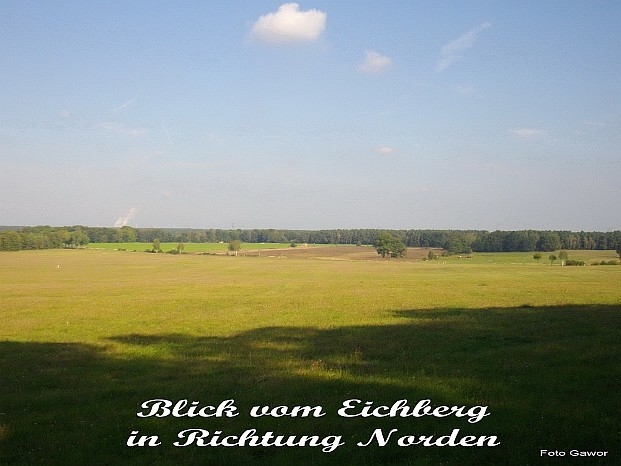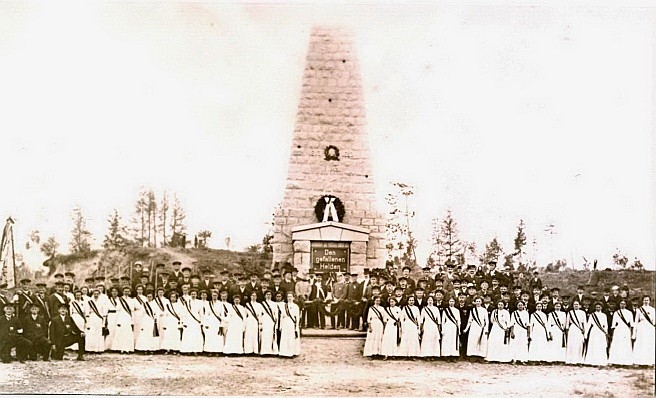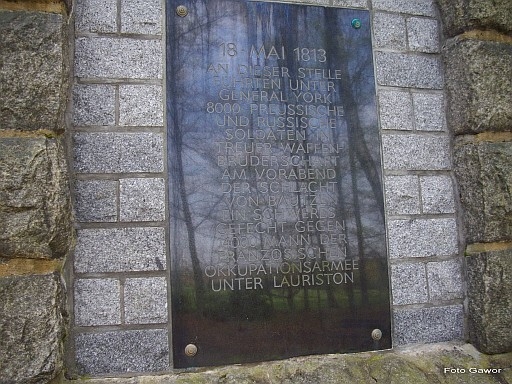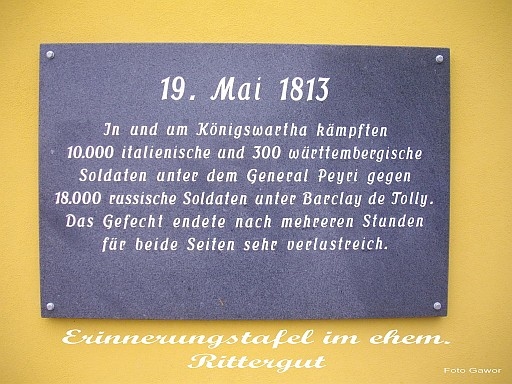Over New Years von W. and I played a pair of games. My research on Eichberg was at that time not complete, but this playtest largely tracks the scenario presented earlier. I took Lauriston's V Corps and von W. led von Yorck's redoubtable Prussians. This was a fun game played out over 14 turns between the two of us.
As I was randomizing the reinforcement arrival times (and would see them in advance as GM), I laid out the French strategy in my mind prior initiating the reinforcement rolls. My plan was the lead French Division commander, upon making contact with an equal or superior force in good defensive terrain was to wait for the next division up the road to arrive in the next hour. My lead division would bombard Weissig, and generally soften up the Prussians with skirmishing/musketry. Once the second division arrived, they would take the woods and area to the left of Weissig, while the first division pinned the Prussian defenders in Weissig and to the right.... that was the plan anyway.
The initial deployment. The time is approximately ~2:30 p.m, May 19, 1813. A little over an hour ago significant cannon fire could be heard to the southwest in the direction of Konigswartha. V Corps is on a strategic flank march, which will ultimately turn the Allied position at Bautzen on the 21st. Von Yorck is part of a spoiling attack lead by Barclay de Tolly to isolate and destroy V Corps. The two sides have blundered into each other near the village of Weissig. The French are in foreground, Weissig and the Prussians middleground, and Hermsdorf in the distance.
Closer view of the Prussian deployment.
 |
Von Yorck siezes the initiative and the Prussian cavalry boldly advances to keep the pesky French chasseurs from delaying the Prussian advance on the strong defensive terrain at Weissig. The French 2nd&3rd Chasseurs face off against the combined Silesian Hussars and get the worst of it. Casualties are light on both sides. The 1st Chasseur's (heroes once again) charge against the flank of the Silesians. The Lithuanian Dragoons (represented by Uhlans today), fail to make their support charge as their horses are too fatigued from the 17 hour march.
The Silesian Hussars are in turn run off.
The Infantry begin to arrive, and the horse batteries unlimber. The light cavalry on both sides withdraws, determining that discretion is the better part of valor, and dying to round shot and canister is the province of the infantry.
The objectives of both cavalry commanders were achieved and the contesting infantry advances were covered. The Prussian infantry got their defensive terrain and the French infantry didnt have to mess around with squares/closed columns. The total casualties for this series of swirling light cavalry combats was 20-45 total (both sides). Morale of units was momentarily shaken, but reserves allowed retreats to be covered and everyone was rallied within 30 minutes. I was very pleased by the whole cavalry skirmish, it felt "right" to me and my interpretation of the role of supporting light cavalry (when not serving a reconnaissance function).
At approximately 3:15 pm, the second Prussian brigade entered from Hermsdorf. Seeing this additional body of men arriving to reinforce the Prussians, Lauriston looked to the north wondering where the hell Maison's 16th Division was.
The French have been bombarding the Prussian positions. The Prussian artillery is concentrated on the French right, as is the cavalry reserves of both sides. Lauriston pulls back his covering forces to reduce casualties, leaving the cavalry and one infantry battalion in position to counter any advance to the west of Weissig.
On the left, the French artillery fire has started to slacken, and the Musketeers of the 1st and 2nd Silesian Infantry regiments charge the battery. The II/153rd Ligne successfully react and counter-charge the 2nd Silesians.
(looking at the number tags in the photos, pretty sure I had von W. deploy von Horn's brigade first instead of von Steinmetz's brigade... oops.)
Fortune favors the sons of France and the II/153rd sends the 2nd Silesians recoiling 300 paces. The 1st Silesians are staggered by the canister fire and fail to close. General von Horn, at the head of the 2nd Silesians suffered a minor arm wound, but was expected to return to the field. Gen. Lagrange and Lauriston are relieved as currently they have only two battalions in reserve. Should the front line have faltered a tactical withdrawal would have been required to stablize the situation.... where is General Maison! In the distance the Lieb Regiment advances to take the place of the Silesians.
Von Yorck receives an order from de Tolly to withdraw to Johnsdorf, but responds that he would not withdraw in the face of the large enemy force before him.
The Lieb advances, but the French guns are practically silent. Von Yorck does not delay a moment, and places himself at the head of the Lieb regiment and encourages the men to the attack.
(WARNING: Soundcloud Seems to Play this Back Very Loudly)
Fortune departs the French, and the exhausted french gunners fire a volley, but the II/Lieb IR closed ranks and took the gun line. The French battery takes significant casualties, but manages to take off 5 of their 8 guns before the Prussians take the position. Similarly von Yorck and the I/Lieb throw the II/153rd Ligne back, and the French infantry are forced to retire 300 paces.
The Prussian success was not however complete. Lauriston threw the I/153rd Ligne at the beleaguered Prussians in the outskirts of Weissig who had been suffering over and hour under constant bombardment. After a limited volley, the Prussians evacuated the outskirts of Weissig in disorder. (I did not know the location of the Eichberg at the time so added extra defenses at Weissig).
To great relief of Lauriston, at approximately 4:15, Gen. de Div. Maison finally arrived with 16th Division.
Gen. Lagrange committed his reserves and charged the I/Lieb, which was forced to retire before the fresh French troops. French howitzers caused a significant fire to erupt in Weissig and the remaining Prussians were unable to contain it and began to evacuate. However, the II/Lieb with von Yorck continued their assault against the disordered II/153rd Ligne, routing the French before them.
This would be the highwater mark of the II/Lieb. Maison's division arrived and began to envelop the overextended Prussians. However, von Yorck and the Prussian Lieb IR would not be so easily defeated.
The leading battalions of Maison's division repeatedly charged against the II/Lieb, but von Yorck skillfully extracted them. Each time the Lieb infantry delivered a volley at close range, and retired in good order facing the enemy. Whenever there was a momentary loss of order, von Yorck was there to retrieve the situation. The II/Lieb refused to be caught and destroyed.
At approximately 6:00 p.m. with the Prussian center and left broken, a tactical withdrawal was ordered to Hermsdorf, where a division of Raiewski's Russian Grenadiers had arrived and deployed in a new defense line. The retreat was covered successfully by the Prussian cavalry except for one of the Prussian batteries which lost 3 guns.
The Results:
Ignore, the other two cannon lost by the Prussians. They were 3-pounders assigned to the Sileisan IRs and of no real consequence.
Results after reinforcements and walking wounded assessed with a French territorial victory modifier.
This playtest was before I had found the local historical information that identified the Eichberg. The second Prussian brigade probably should have started on table and my scenario reflects that adjustment. I randomized both the reinforcement of the Prussian 2nd brigade and the 2nd French division based on an arrival for turn 4, and got a result of turn 3 for the Prussians and turn 7 for the French.
Overall I think the scenario gives the historical impression of the battle as a meeting engagement, between two relatively equal forces in relatively constrained defensive terrain with plenty of room for variation. The forces engaged can be manageable for two players, or scale up depending on how you set the reinforcements and the table.
Up Next the First Counter-factual Scenario and Playtest.





















